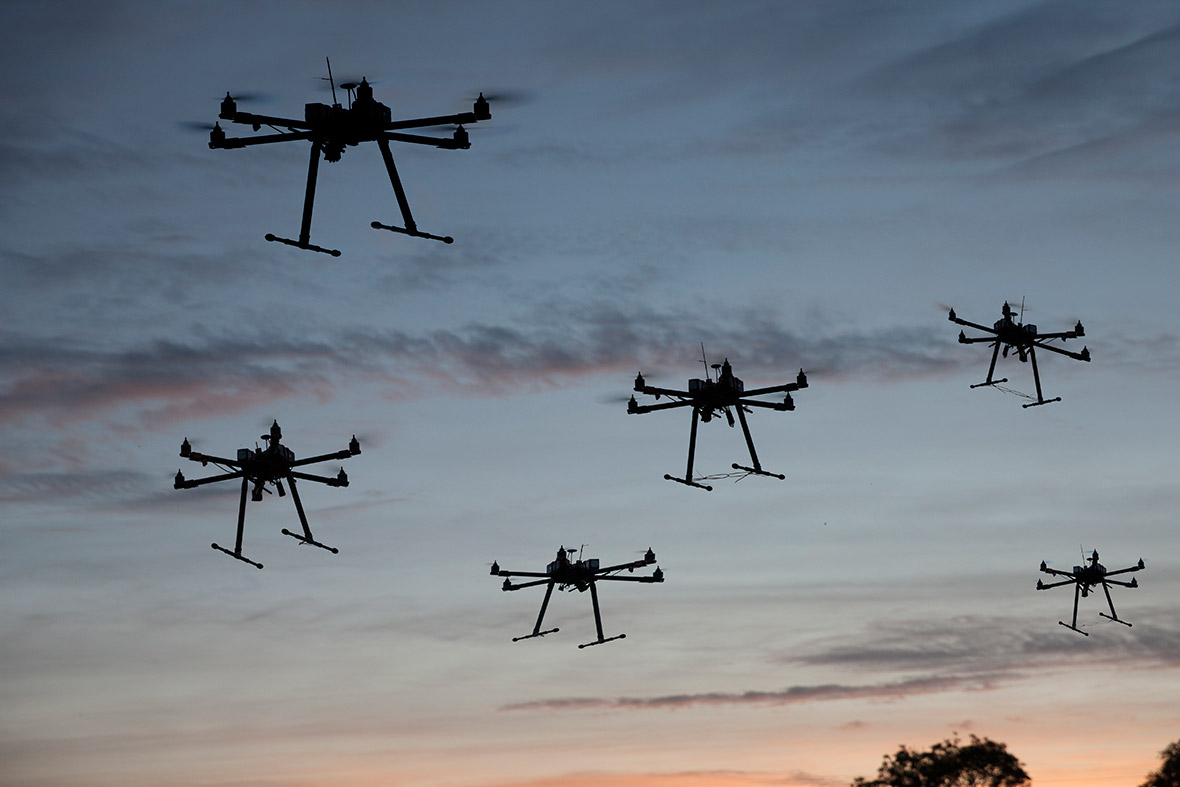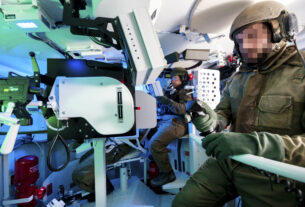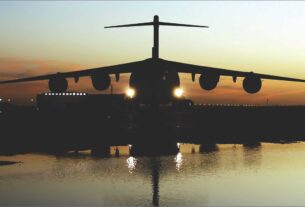Robotic technology and use of UAV in battle zoneThe role of Unmanned Aerial Vehicles (UAVs) in modern warfare has evolved with each successive conflict, from naval gunfire support during the 1991 Gulf War to real time satellite relay of video over Kosovo in 1999 to attacking mobile Al Qaeda fighters in Afghanistan in 2002/2003.
Afghanistan marked the formal debut of the Hellfire-carrying Predator, giving warfighters a sneak preview of what tomorrow’s dedicated Unmanned Combat Air Vehicles (UCAVs) promise to offer.
Supporting US Special Forces in search of Al Qaeda operatives, the Predator was credited with the assassination of the terrorists’ chief of military operations.
More recently, it was widely credited with the killing of another senior Al Qaeda figure in Yemen. The Predators provide sustained sensor/shooter presence, enabling commanders to have new levels of recognition, tracking and interdiction of target areas, once considered impossible.
Equipped with optical sensors with resolutions good enough to read road signs from 4.5km away, the Predator allows operators to identify and distinguish human targets, to follow them if they were motorised, and to destroy them even if armoured.
Armed forces worldwide are beginning to explore the possibilities offered by unmanned systems as both sensor and weapons platforms.
The promise of an autonomous, highly survivable and absolutely fearless UAV will usher in a new paradigm in which the ultimate consideration is no longer the value of pilots’ lives, but rather the mission and cost effectiveness of UAVs.
Nations have to carefully study and redefine the value of human operators – where and how much to do away with humans, bearing in mind the costs to the economy at large. At the same time, unmanned systems have to evolve such that they can perform as well as, if not better than, current manned systems in order to gain the confidence of military commanders.
Today, continued advances in unmanned systems technology are pushing the envelope in terms of performance, propelling UAVs into a greater variety of missions and applications to be true force multipliers.
UAVs will track the paradigm shift towards a network-centric warfare concept, seamlessly integrating into all three key areas of defence systems encompassing the sensor, shooter and Command and Control (C2) network. UAVs will allow the force commander to “see first, understand first, act first and finish decisively” by providing platforms for deploying sensors, weapons, and communications architecture.
UAV or rather RPV (Remotely Piloted Vehicle) history could be traced back to the early 70s when it was recognised the potential of RPV to provide real-time aerial imagery intelligence to the ground forces.
The Searcher UAV, a medium size UAV system, is 5m long and has a wingspan of 7.6m. It can operate autonomously up to 100km from its Ground Control Station (GCS).
To ensure that pilots are proficient in operating the UAVs, DSTA also conceived and needs to be implemented the UAV training simulator.
The furious drive towards UAV deployment in every theatre of war has seen the debut of many revolutionary concept UAVs including future Unmanned Battlefield the X-45 UCAV, the Neptune Maritime UAV and the X-50 Canard Rotor Wing (CRW).
Increasing demand for better performance and higher reliability will escalate the development and production cost of UAVs. Whether the platform is designed to be better than manned rated aircraft or expendable depends on its application, the payloads it carries, mission pay-off and cost effectiveness.
The misconception that all classes of UAVs will be low cost and expendable has severe consequences downstream. Policy makers in the US are beginning to re-examine their long history of cancelled UAV developmental programmes in the light of unrealistic cost expectations.
The $268 million DarkStar concept demonstration programme is an appropriate example. Lockheed Martin abandoned the stealthy HAE (High Altitude Endurance) UAV due to the unrealistic, unattainable unit flyaway price of US$10 million set by Defence Advanced Research Projects Agency (DARPA).
Even the successful non-stealthy HAE counterpart, the Global Hawk, ended up with US$644 million in developmental costs, and a whopping US$73.7 million unit flyaway price (Leonard and Drezner, 2002).
For strategic high-value UAVs to perform as well as manned systems, US policy makers are beginning to acknowledge that unmanned system developmental programmes will have similar complexity, and hence acquisition cost.
This shift towards realistic price expectations can be seen in the X-45 Unmanned Combat Air Vehicle (UCAV) Advanced Technology Demonstrator (ATD) which has cost US$655 million to date, with significant work on both airframe and payload integration yet to be done.
UAVs have traditionally been employed as sensor platforms in intelligence, surveillance and reconnaissance (ISR) missions, target acquisition, battle damage assessment, SIGINT, COMINT (Communications Intelligence) and ELINT (Electronics Intelligence).
The advent of light airborne precision weapons, autonomous target acquisition and recognition technologies will push UAVs towards becoming armed and lethal unmanned platforms.
UAVs with the ability to pick out targets and attack autonomously with persistent presence over areas of interest will come of age in the near future and commanders are beginning to see them as indispensable weapons of war.
The continued development of strategic and tactical UAVs follows the line of employing UAVs as multi-role multi-mission platforms. UAVs will see progressive developments towards both extreme ends of the size spectrum.
Strategic UAVs will see continuous growth in size for better endurance, reliability and payload capacity, while the mini- and micro- UAVs will grow smaller, lighter and more expendable. The tactical, close range platforms will become more versatile, with multi-mission, multi-role capability.
Tactical UAV Tactical UAVs (TUAVs) will evolve towards multi-role multi-mission platforms. As UAV technology matures, we see that UAVs become increasingly cost effective as they adopt more missions per platform MTOW – they either have to grow smaller, or be able to satisfy a greater number of missions and roles.
Besides current applications in Reconnaissance, Surveillance and Target Acquisition (RSTA), the tactical UAV mission set could be expanded to include target designation, strike, chem-bio detection, mine countermeasures,
Theater Air Missile Defense, electronic warfare and information warfare. The near-term solution to the US Army’s requirement for TUAVs includes the RQ-7A Shadow 200 expected to be fielded this year at the brigade level. However, the US Army’s Future Combat Systems (FCS) programme envisions a family of UAVs to serve at every echelon – not unlike the Fox AT programme championed by the European Aeronautic Defence and Space Company (EADS).
Payloads with functional and/or architectural commonality would be deployed on disparate TUAVs to reduce payload developmental costs and allow cost savings from economies of scale.
Boeing’s proposal for the FCS programme spans the size spectrum of TUAVs (Tactical UAVs), including man-packable Micro Air Vehicles (MAVs), organic VTOL (Vertical Take-Off and Landing) UAVs carrying 4.5 kg payloads for one hour, tube-launched UAVs with endurance of six to eight hours at 1,000 ft, and a Shadowlike TUAV flying at 15,000 ft.
Micro UAV (MAVs) have significant military and law enforcement utilities because they are less detectable, cheap to produce, truly expendable and can be organic to smaller units such as special task forces, groups and companies, providing over-the-hill and urban area reconnaissance at reduced signature without risk to the personnel.
MAVs take the other path towards cost effectiveness – growing smaller and smaller. Advances in payload miniaturisation continue relentlessly with integrated MicroElectromechanical Systems (MEMS) reducing payload sizes to that of the average silicon chip.
While the performance of such sensors may not be as impressive as their larger counterparts, their small size, weight and power requirements make for deployment on increasingly smaller vehicles allowing close-up surveillance.
Australia’s Defence Science and Technology Organisation (DSTO) successfully test flew a micro robotic aircraft. The 1kg aircraft carried an electronic ocelli, an optical payload designed to mimic dragonfly vision, weighing a mere 5g.
Experience with Vertical Take-Off Landing (VTOL) UAVs has been rather dismal over the last 10-15 years. Technology challenges and cost overruns led to repeated cancellation of developmental programmes.
The past “casualty” include EADS’ Seamos and Bombardier’s CL-327. Despite the performance penalties suffered by the VTOL aircraft, there remains a market for such UAVs especially for operations where space is limited – such as surface vessels and urban warfare.
Further technological advances in areas such as shrouded rotors, composite manufacturing processes and canard rotor wings will usher in smaller, more capable VTOL UAVs ensuring their continued relevance in the future battlefield.
VTOL UAVs provide a small, highly maneuverable platform to conduct overhead surveillance, remote sensing, communications relay and ultimately “fly-on-the-wall” surveillance. The low cost, unmanned VTOL craft is particularly attractive for ISR applications as opposed to the manned option.
They have small footprints and lower signatures. They also save costs associated with piloted craft, eliminate casualties and are easily portable to the area of operations.
Shrouded rotor concepts as employed by ST Aerospace’s Mini-Tailsitter or FanTail and Allied
Aerospace’s iSTAR provide more thrust than the open blade design of conventional helicopters. Besides improving system safety, the shrouded rotor allows diameter reduction of VTOL rotors and hence platform sizes without compromising on performance.
Revolutionary manufacturing processes allow the low cost production of complex rotors which represent a quantum leap in VTOL performance. Instead of the present lightweight flexible rotors that are connected to the rotor hub through articulated joints, the A160 Hummingbird has carbon-fibre composite rotor blades which are tapered and possess variable cross sections from the blade root to tip.
The stiffness varies from the root to tip allowing a rigid and hingeless system, which features a larger diameter and lower disk loading, compared to a conventional helicopter rotor system with the same lift capacity.
The rotor blades are electromechanically actuated and can operate from 140 to 350 rpm. With low disk loading and rotor tip speeds, the variable speed rotor system is able to give efficient low power loiter. Revolutionary concepts such as the X-50 Canard Rotor/Wing (CRW) Dragonfly combine VTOL capability with the advantages of fixed wing aircraft to give the best of both worlds.
The developmental CRW is a stoppable rotor design which allows both VTOL capability and efficient high speed cruise. E. Unmanned Combat Air Vehicles The military establishment has always conceived the UAV as a sensor platform, leaving the manned systems to take up the role of shooter platforms due to their perceived value-add in making real-time decisions and in-flight mission reconfigurations.
However, two main factors have prompted a shift in this conception, towards the employment of UAVs as attacking platforms: the limits of pilot physiology, and the need for reduced sensor-to-shooter times. The Unmanned Combat Air Vehicles (UCAV) is unfettered by a pilot’s physiological constraints.
Unlike manned fighters, the UCAV can go beyond the 10g regime, has no need for controlled environment (temperature, pressure and oxygen), is truly fearless, is able to handle multiple sources of information and address them through real-time multi-tasking.
Also, experiences in Kosovo have prompted a re-examination of the Observation, Orientation, Decision and Action (OODA) loop in order to reduce the latency between sensor and shooter. During this campaign, targets of opportunity spotted by the Predator UAV eluded destruction due to the time it took for attack aircraft deployed from Italy to engage these targets.
In order to shorten the sensor-to-shooter cycle, efforts were made to adapt the Predator UAV to launch Hellfire missiles, with the first missile launch successfully conducted in February 2001 destroying a stationary Army tank. The AGM- 114 Hellfire armed Predators have subsequently been field-proven in Operation Enduring Freedom, providing a critically needed interim solution for engaging time critical targets.




